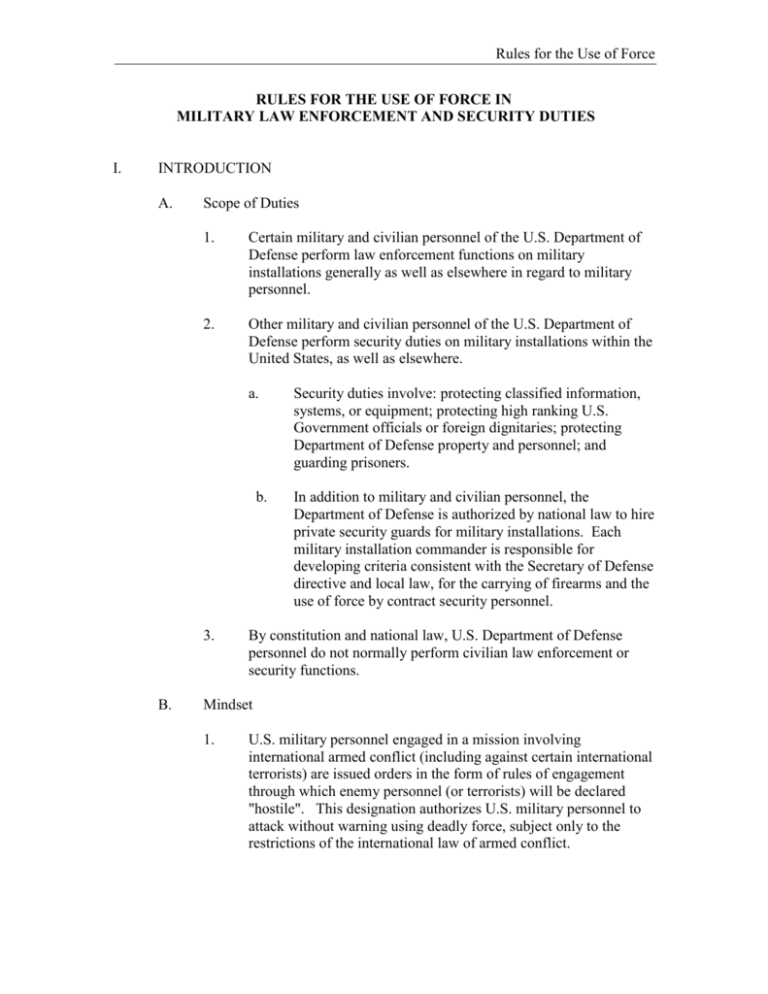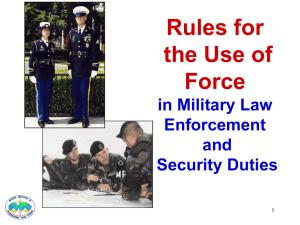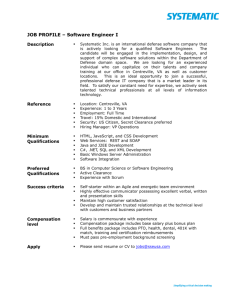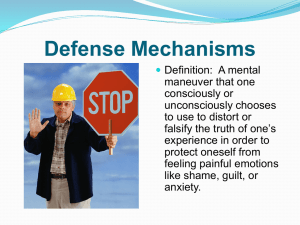imminent coast
advertisement

Rules for the Use of Force RULES FOR THE USE OF FORCE IN MILITARY LAW ENFORCEMENT AND SECURITY DUTIES I. INTRODUCTION A. Scope of Duties 1. Certain military and civilian personnel of the U.S. Department of Defense perform law enforcement functions on military installations generally as well as elsewhere in regard to military personnel. 2. Other military and civilian personnel of the U.S. Department of Defense perform security duties on military installations within the United States, as well as elsewhere. a. b. 3. B. Security duties involve: protecting classified information, systems, or equipment; protecting high ranking U.S. Government officials or foreign dignitaries; protecting Department of Defense property and personnel; and guarding prisoners. In addition to military and civilian personnel, the Department of Defense is authorized by national law to hire private security guards for military installations. Each military installation commander is responsible for developing criteria consistent with the Secretary of Defense directive and local law, for the carrying of firearms and the use of force by contract security personnel. By constitution and national law, U.S. Department of Defense personnel do not normally perform civilian law enforcement or security functions. Mindset 1. U.S. military personnel engaged in a mission involving international armed conflict (including against certain international terrorists) are issued orders in the form of rules of engagement through which enemy personnel (or terrorists) will be declared "hostile". This designation authorizes U.S. military personnel to attack without warning using deadly force, subject only to the restrictions of the international law of armed conflict. Defense Institute of International Legal Studies 2. C. U.S. military and civilian personnel engaged in law enforcement or security duties are issued orders in the form of standing rules for the use of force which govern the use of force in the carrying out their duties such as arresting persons suspected of committing crimes and the protection of persons and property. The use of deadly force is authorized only in very limited circumstances. Legal Framework 1. In performing assigned law enforcement and security functions, U.S. Department of Defense personnel may be required to use force. 2. A U.S. national law authorizes civilian officers and employees of the Department of Defense to carry firearms or other appropriate weapons while assigned investigative or other duties under regulations prescribed by the Secretary of Defense. 3. The Secretary of Defense has issued a Directive governing the carrying of firearms and the use of deadly force by Department of Defense military and civilian personnel performing law enforcement and security duties. a. The Directive does not apply to personnel engaged in military operations, contingencies, and routine Military Department functions occurring outside U.S. territory and territorial waters. It also does not apply to air and maritime homeland defense missions in the U.S. These are governed by authorized rules of engagement. b. Department of Defense personnel detailed to support federal agencies engaged in law enforcement operate under common mission-accomplishment specific rules for the use of force approved by both the Secretary of Defense and the federal agency involved. However, for self-defense, such personnel follow Department of Defense standing rules for the use of force. c. Department of Defense personnel under U.S. Coast Guard control follow the use of force policy for warning shots and disabling fire issued by the Coast Guard. However, for self-defense, such personnel follow Department of Defense rules of engagement outside U.S. territory and territorial waters, and Department of Defense standing rules for the use of force inside U.S. territory and territorial waters. 2 Rules for the Use of Force 4. 5. II. d. The Directive also does not apply to duties involving civil disturbances. When military personnel are assigned riot control duties within the U.S., rules of engagement are developed for each specific mission. An example is provided as an appendix at the end of this module. e. When drafting rules of engagement for conducting military operations other than war outside the United States, military commanders often find this Directive offers useful, though non-binding, guidance regarding when deadly force should be used to protect civilians and property. The Secretary of Defense has also approved standing rules for the use of force for U.S. forces, civilians, and contractors performing law enforcement and security duties at all military installations and in other Department of Defense security functions. These rules are distributed by the Chairman of the Joint Chiefs of Staff in an instruction. a. These rules also apply to Department of Defense personnel performing civil support missions, routine Service functions, and land homeland defense missions within U.S. territory. b. Application of the standing rules for the use of force may be limited in another nation’s territory by that nation’s laws and by international agreements with that nation. The Secretary of each Military Service has issued written a regulation or instruction which complies with the standing rules for the use of force issued by the Secretary of Defense. In addition, the Secretary of Defense Directive authorizes Secretary of each service to establish additional considerations in implementing procedures over the use of firearms. GENERAL GUIDANCE ON ARMING LAW ENFORCEMENT & SECURITY PERSONNEL A. Personnel regularly engaged in law enforcement or security duties shall be armed. Personnel occasionally engaged in such duties may be armed. 1. The Army implementing regulation is more restrictive in that it encourages commanders to substitute nonlethal devices for firearms when considered adequate for safely performing law enforcement and security duties. Defense Institute of International Legal Studies B. III. Authorization to carry firearms is granted by Heads of Department of Defense Components or their designees. All authorizations must be in writing except in situations requiring immediate action to protect life or vital government assets. 1. As required by U.S. national law, no Department of Defense law enforcement or security personnel who have been convicted of a misdemeanor crime of domestic violence shall be authorized to carry or possess a firearm. 2. The implementing regulation or instruction of each of the services includes additional disqualifying criteria. For example, the Army disqualifies personnel who have (among other things) used illegal drugs, are diagnosed as alcohol dependent or an alcohol abuser, have a history of negligence or delinquency in performing their duty, or have been involved in a serious incident of misconduct. C. Personnel issued firearms are required to complete annual qualification training, use of deadly force training, and proficiency testing. D. Personnel authorized to retain firearms at their residence or nongovernment locations are required to use issued safety locking devices and instructions for their use. E. The Army implementing regulation also prohibits personnel who have either taken prescription drugs or other medication that may produce drowsiness or impair reaction or judgment from carrying firearms. It also prohibits the carrying of firearms if they have consumed alcoholic beverages less than eight hours before. GUIDANCE ON THE USE OF FORCE BY LAW ENFORCEMENT & SECURITY PERSONNEL A. Law enforcement and security personnel are required to carry out assigned duties without resorting to the use of force when possible. B. When force is warranted in carrying out law enforcement or security duties, or in self-defense and defense of other military personnel in the vicinity in response to a hostile act or hostile intent, the minimum force necessary is required to be used. 1. The Army regulation adds the additional guidance that in evaluating the degree of force required in a specific situation, the following options should be considered in order: 4 Rules for the Use of Force a. b. c. d. e. f. g. IV. verbal persuasion unarmed defense techniques chemical aerosol irritant projectors MP club military working dogs presentation of deadly force capability deadly force C. Warning shots are prohibited. D. When time and circumstances permit, persons threatening force should be warned and given the opportunity to cease threatening actions. E. The Army implementing regulation adds that a firearm should not be removed from its holster unless there is a reasonable expectation that use of the weapon may be necessary. GUIDANCE ON THE USE OF DEADLY FORCE BY LAW ENFORCEMENT & SECURITY PERSONNEL A. The Army implementing regulation specifies that when a firearm is discharged, it will be fired with the intent of rendering the person(s) at whom it is discharged incapable of continuing the activity or course of behavior prompting the individual to shoot. B. The Army regulation also requires that shots be fired only with due regard for the safety of innocent bystanders. C. Deadly force is to be used only when all lesser means have failed or cannot reasonably be employed, and reasonably appears necessary for one or more of the following purposes: 1. when a person poses an imminent threat of death or serious bodily harm either to law enforcement and security personnel or to other persons in the vicinity; 2. to prevent the commission of a serious offense involving an imminent threat of death or serious bodily harm; 3. to prevent theft or sabotage of an asset vital to national security; Defense Institute of International Legal Studies 4. to prevent the theft or sabotage of property that, in the hands of an unauthorized person, would create an imminent threat of death or serious bodily harm; 5. to prevent the sabotage of national critical infrastructure; 6. to arrest or apprehend a person who, there is probable cause to believe, has committed a serious offense involving an imminent threat of death or serious bodily harm; 7. to prevent the escape of a prisoner whom there is probable cause to believe: has committed or attempted to commit a serious offense involving an imminent threat of death or serious bodily harm. 6 Rules for the Use of Force APPENDIX LOS ANGELES CIVIL DISTURBANCE RULES OF ENGAGEMENT (ROE) (1992) JOINT TASK FORCE L.A. Background: In May 1992, the City of Los Angeles experienced extensive rioting following the jury trial acquittal of local policemen who had been charged with badly beating a citizen (Rodney King) while in the process of arresting him. A military Joint Task Force (JTF) was assigned the difficult task of controlling rioting which threatened the safety of every local citizen as well as their property. The JTF was responsible for developing "civil disturbance" ROE that would be useful and geared for such an environment. The JTF Commander promulgated the following rules after consulting all commanders making up the JTF Using local purchase procedures, an officer acquired 12,000 pocket sized copies of the ROE, which then were distributed to the troops throughout Los Angeles. JTF LOS ANGELES ROE A. Every service member has the right under law to use reasonable and necessary force to defend himself against violent and dangerous personal attack. The limitations described below are not intended to infringe this right, but to prevent the indiscriminate use of force. B. Force will never be used unless necessary, and then, only the minimum force necessary will be used. (1) Use Non-deadly force to: (a) Control the disturbance; (b) Prevent crime; or (c) Apprehend or detain persons who have committed crimes. (2) Use deadly force only when: (a) Lesser means of force are exhausted or unavailable; and (b) The risk of death or serious bodily harm to innocent persons is not significantly increased by the use and the purpose is: 1- Self defense, to avoid death or serious bodily injury; 2- Prevention of crime involving death or serious bodily harm; 3- Prevention of destruction of public utilities that have been determined vital by the JTF commander; or Defense Institute of International Legal Studies 4- Detention, or prevention of escape, of persons who present a clear threat of loss of life. (3) When possible, the use of deadly force should be preceded by a clear warning that such force is contemplated or imminent. (4) Warning shots will not be used. (5) When firing, shots will be aimed to wound, if possible, rather than kill. (6) Weapons will not be fired on automatic. (7) When possible, let civilian police arrest lawbreakers. (8) Allow properly identified news reporters freedom of movement, so long as they do not interfere with your mission. (9) Do not talk about this operation, or pass on information or rumors about it to unauthorized persons, refer them to your commander (10) The JTF commander withholds authority for use of riot control agents or sniper teams. Outcome: These carefully crafted ROE accomplished their purpose. The service members deployed in JTF Los Angeles carried approximately 350,000 rounds of ammunition and 3,700 tear gas grenades, but fired only twenty rounds throughout the entire crisis. Unit commanders strictly accounted for each shot fired. National Guard soldiers fired fourteen shots at an individual who attempted to run them down with his car. Task force members fired two more rounds at another person who tried to run over police and National Guard soldiers. The final four rounds were used in subduing a robber suspect who resisted arrest. 8








